Also known variously as “breakfast casserole” and “egg dish”, strata is an American brunch favourite that, according to the great US chef Sohla El-Waylly, is best described as “the love child of frittata and bread pudding”, while the dish’s name comes from the fact that it’s assembled in layers. Like all the best leftovers recipes, those layers are eminently flexible, but what all strata have in common are stale bread and eggs. The rest is largely up to you.
I’ll be honest, rich as it is, strata is not something I’d tackle before lunchtime, so I was relieved to read the late James Villas explain that, “in the South, a strata is traditionally served on an informal dinner buffet or at a casual supper”. Whenever you plan to enjoy it, however, note that, as per America’s favourite cookbook, The Joy of Cooking, if need be the ever amenable strata “can be assembled and refrigerated overnight, then baked the next day, leaving you nothing to do but brew the coffee”. Or mix the bloody marys.
The bread
This recipe should comfortably accommodate any savoury bread you wish to use up – rye bread, corn bread, even garlic bread will all give your strata a slightly different character – though I’d avoid anything too delicate, such as brioche. Samuel Goldsmith suggests sliced baguette in the spinach and tomato version in his Tinned Tomatoes Cookbook, there’s a smoked salmon one with bagels on Food52 and multiple croissant-based takes online.
Most writers, however, call for either a “quality white sandwich loaf” or “supermarket-style ‘French’ or ‘Italian’ bread”, for which I use a supermarket ciabatta. I prefer the more robust, chewy texture of the latter, or sourdough; the white tin loaf all but dissolves into the custard, especially when used fresh. For this reason, I’ve suggested crisping the slices up in the oven first. Arlyn Osborne, writes on Serious Eats that drying the bread in the oven “extracts moisture while leaving the crumb’s structure intact, making oven-dried bread a better option than stale bread”. She adds that the restructuring of starch molecules during the staling process makes for tough, rather than crunchy bread. However, this is first and foremost a recipe that’s about using up leftovers, so if you have thoroughly stale bread already, by all means skip that step – it will still be good.
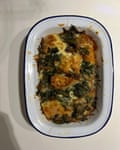
Most strata involve cubes of bread, which is odd, because, as Villas notes rather tartly, “if the primary ingredients are not arranged in alternate layers, the dish is not a genuine strata but an ordinary casserole”. Thick slices will, as Cooks Illustrated observes, help keep the layers intact and make for a neater end result. (Again, if you’re using a loaf that doesn’t lend itself to slicing, just cut or tear it into chunks instead.)
The custard
The recipes I try are divided between those who make their strata with an enriched white sauce thickened with flour, such as Villas’ and chef and writer Amy Thielen’s; and those, such as Cooks Illustrated, Osborne and Melissa Clark in the New York Times, who prefer an egg custard (which seems to be the more common modern choice). The benefit of the former is that it’s cheaper, less temperamental and can be made as rich or plain as you like simply by adjusting the number of eggs you beat in at the end. But a dish of bread baked with a starchy sauce could be accused of being rather stodgy, especially first thing in the morning. The custards are more delicate and almost quiche filling-like in the case of those containing heavy cream (the US equivalent of British whipping cream.
Because this is, in theory, a breakfast dish, I’ve come down on the egg custard side of the argument, but my testers find some examples offputtingly “fluffy”, bringing back traumatic memories, they claim, of school dinner flans. I put that down to the high milk content – the more water in the emulsion, the more risk of it breaking in the heat of the oven. Mixing the milk with something that’s higher in fat, such as cream, is good insurance, and makes for a firm, silky result rather than a watery, weepy one. I’ve gone for tangy creme fraiche, but any thick cream will do the job.
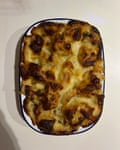
Thielen brings some Minnesota flair to the “egg dish” in her book The New Midwestern Table by including layers of sliced, cooked eggs rather than whisking raw ones into the sauce. However, although we enjoy the rest of her dish, the baked hard-boiled eggs are deemed a bit dry and rubbery; Clark’s idea of cracking raw eggs on to the top of the strata halfway through baking feels a better choice if you’d like extra protein.
The flavourings and ingredients
Strata are a good vehicle for more than old bread – leftover vegetables, meat scraps and ends of cheese can all go in, so it’s worth bookmarking this recipe for Twixmas. The recipes I try use spinach (both fresh and frozen) baby leaves, curly kale, ham, bacon, leek and mushrooms, as well as soft goat’s cheese and several sorts of hard stuff including gruyere, mild cheddar and parmesan. The golden rule is, as so often in baking, to make sure you get rid of as much water as possible before introducing them to the other ingredients, which means pre-cooking the vegetables. (Loth as I am to disagree with the great Villas’ The Glory of Southern Cooking, raw mushrooms do tend to leak a lot of water, frying the bacon and so on.
Clark’s recipe whizzes greens (baby kale, mustard greens, chard) and herbs into the custard itself, turning it a vibrant green, which looks great, though my testers and I miss the texture of the layer of leaves. She also introduces parmesan to the custard itself, which, if you want cheese to be more of a seasoning than a star player, is a great idea. If you hanker for the stretchy pull of melted cheese, however, then deploy a milder, softer variety as a layer in its own right; gruyere, emmental, red leicester, double gloucester or a medium cheddar are all ideal candidates, but, again, it’ll work with just about any combination you have handy. Match your seasonings to the ingredients: mustard, Tabasco, fresh thyme … if it wouldn’t be out of place in a quiche, or folded into scrambled eggs, it’s a fairly safe bet in a strata, too.

I’ve gone for a classic combination of spinach (this is a great place for the frozen variety), leek and cheese, with a grating of nutmeg, but replace those as you see fit; an easy way to judge how much you need of a particular ingredient is simply to scatter it across the base of the baking dish to see if you can get two layers out of it. Garlic and nutmeg feel inevitable with spinach, but if it’s too early in the day for the former as far as you’re concerned, you could always leave it out, or indeed replace it with spring onion, shallot or a mild red onion.
If you’re thinking of having this for lunch or dinner, you might also want to consider replacing some of the liquid in the custard with chicken or vegetable stock, or flavouring it with a few spoonfuls of dry white wine reduced by half, as in Cook’s Illustrated’s recipe; both give it a slightly more complex, dare I say sophisticated flavour profile. No one wants that at breakfast time.
The resting and cooking
Thielen is the only one not to give the custard a chance to soak into the bread before baking, proving that if you’re running late, the situation is not irretrievable. That said, the layers will hold together better if they’re left to sit – I don’t find much difference between Cook’s Illustrated’s single hour and Villa’s six, and you can even leave them to mingle overnight, if you wish, preferably with a weight on top to help with more crisply defined strata.
As with anything custard-based, keep the oven temperature moderate to avoid it curdling – 160C ((140C fan)/325F/gas 3) rather than the 180C ((160C fan)/350F/gas 4) called for by many recipes – and leave it to rest before serving, because eggs taste far better warm than hot.
Strata doesn’t freeze well, but it can be made a day ahead. These quantities can be easily scaled up or down, too.
Perfect strata
Prep 20 min
Chill 1 hr +
Cook 1 hr 50 min
Serves 4-6
About 250g bread – I like sourdough or ciabatta
1 tbsp olive oil
1 small leek, trimmed and finely sliced
250g frozen spinach, defrosted, or about 500g fresh spinach, wilted in a large pan with a splash of water
2 garlic cloves, peeled and crushed
Salt and black pepper
6 eggs
100g full-fat creme fraiche, or double cream
175ml whole milk
Nutmeg
Butter or oil, for greasing
100g grated cheese (eg, gruyere, emmental, medium cheddar)
Unless your bread is already rock hard and crunchy, heat the oven to 120C (100C fan)/gas ½. Slice the bread thickly (about 1½cm), then spread it out on a baking tray. Put in the oven for about an hour, turning once halfway, until dry and crisp, then remove and leave to cool.
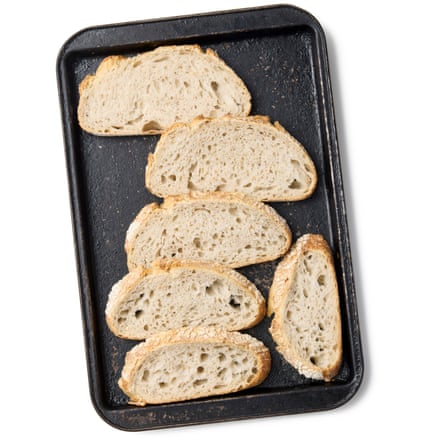
Meanwhile, heat half the oil in a frying pan on a medium-low heat and saute the leek until soft and limp, but not brown. Scoop into a medium bowl.
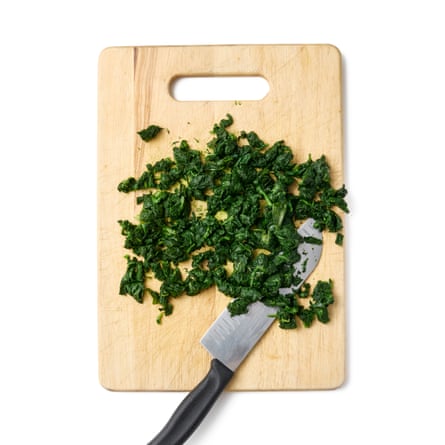
Squeeze as much water out of the spinach as possible, then roughly chop. Heat the rest of the oil in the same pan, add the garlic and fry for a minute or so, until fragrant. Stir in the the spinach, fry until the pan is dry, then mix into the leek bowl and season.
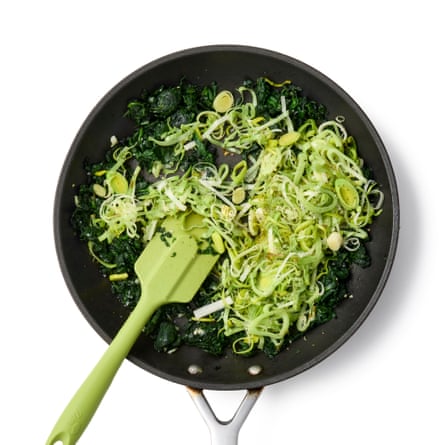
Beat the eggs thoroughly in a jug, then whisk just enough of them into the creme fraiche to loosen it. Once that’s thoroughly combined, tip back into the jug, add the milk, beat again, then season generously with salt and nutmeg.
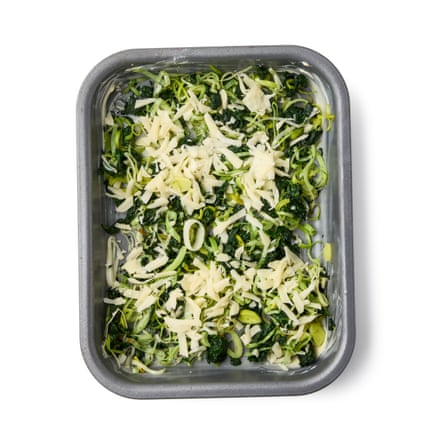
To assemble, grease a baking dish that’s just large enough to hold the bread in two layers, then spread half the greens and a third of the grated cheese in the base. Top with half the bread, then repeat, keeping back the last of the cheese for later.
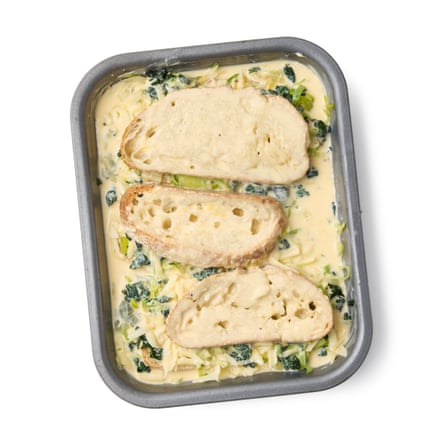
Pour the custard all over the top of the second layer of bread (it should be all but submerged), cover and chill, ideally with something heavy on top to weigh it down and compress. Leave for at least an hour, though overnight is fine.
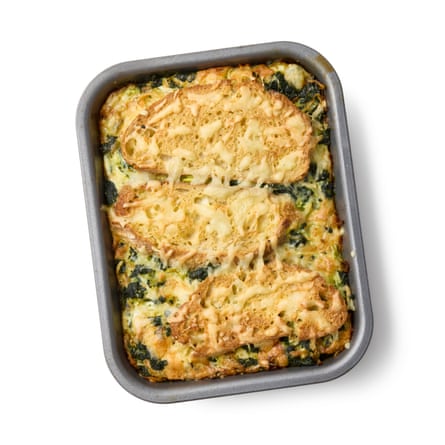
Heat the oven to 160C (140C fan)/325F/gas 3. Take the strata out of the fridge and sprinkle the remaining cheese all over the top. Bake for about 50 minutes, until golden on top, then remove and leave to cool slightly before serving.
-
Strata, breakfast casserole, egg dish: why has this brunch of champions never caught on outside the US? And, with Sohla El-Waylly recommending pizza- and southwestern-themed versions, what’s the best spin on it you’ve found?

.png) 3 hours ago
2
3 hours ago
2

















































